Statement on Monetary Policy – August 2018 1. The International Environment
Global economic conditions generally remain positive. GDP growth in many of Australia's major trading partners – particularly in the major advanced economies – has been above estimates of potential growth for a number of years, and is expected to remain so over the next couple of years (Graph 1.1). This has led to a reduction in spare capacity in the advanced economies and a pick-up in wages growth.
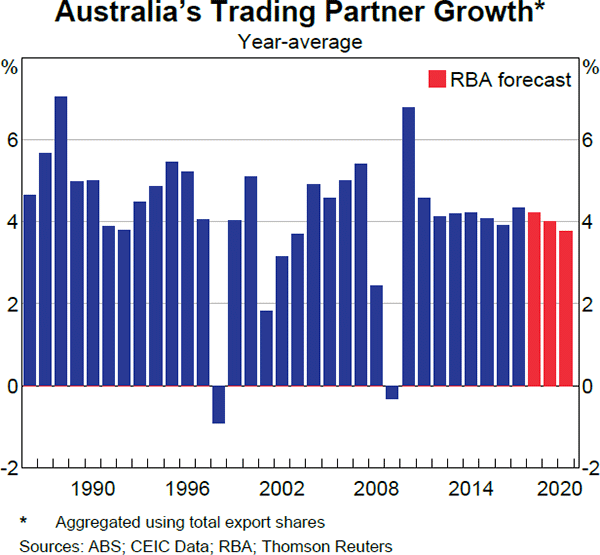
Headline inflation has also increased a little since the start of the year, driven by higher energy prices. Core inflation is close to the inflation target in a number of advanced economies, including in the United States where it has increased over the course of this year. However, core inflation remains little changed and below the inflation target in other advanced economies, including in the euro area and Japan. Nevertheless, inflationary pressures are expected to increase as spare capacity continues to be absorbed.
The major central banks are at different phases of their monetary policy cycles. Policy stimulus has gradually been reduced in the United States and to a lesser extent in Canada and the United Kingdom. Elsewhere, monetary policy settings have been little changed over the past year. The balance sheets of the Bank of Japan (BoJ) and the European Central Bank (ECB) continue to expand, although the ECB has announced that it will cease its program of net asset purchases at the end of this year. Overall, financial conditions remain supportive of economic growth in the major advanced economies.
Growth in the Chinese economy has eased a little since last year. In part, this reflects efforts by the Chinese authorities to make growth more sustainable by addressing risks in the financial system and reducing pollution. In recent months, the authorities have responded to the slowing in growth by easing fiscal policy and taking targeted measures to ensure there is ample liquidity in the banking system.
Against this positive backdrop for the global economy, risks around trade protectionism have increased. This has weighed on equity prices in Asia and some industries. In addition, in a few emerging market economies that have significant political and economic vulnerabilities, currencies have depreciated, equity prices have declined and bond spreads have risen.
Global economic growth remains solid …
Global GDP growth remained solid in the first half of 2018. GDP growth in the major advanced economies has remained above estimates of potential growth – notwithstanding some divergence in conditions of late – and spare capacity continues to be absorbed. GDP growth in China was quite strong in the June quarter, but conditions overall have eased a little since last year. Growth in the rest of east Asia has picked up over the past two years to be a little above potential. Survey measures of global activity remain at high levels, although they have eased in the euro area this year, and growth in global industrial production and trade has remained relatively high (Graph 1.2).
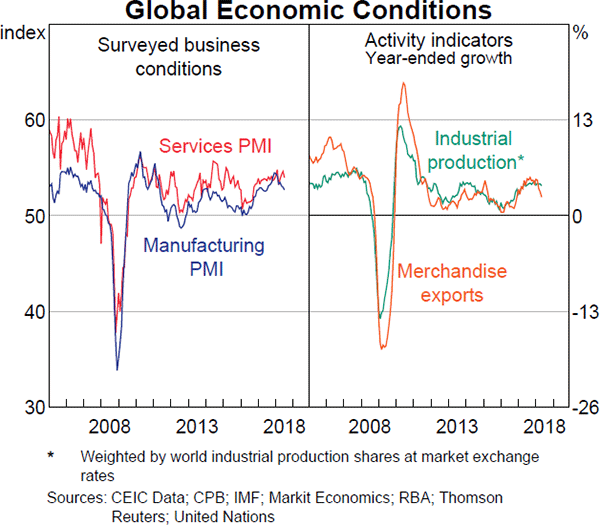
… and the outlook for trading partner growth remains positive …
Overall GDP growth in Australia's major trading partners is expected to be little changed in 2018, supported by accommodative financial conditions, strong labour markets in the advanced economies and the US fiscal stimulus. Some easing in growth is expected over the forecast period, however, as economies adjust to the build-up in capacity pressures and monetary policy accommodation is gradually removed. US growth is expected to ease as financial conditions tighten. Growth in Japan is likely to be temporarily lower in late 2019 and early 2020 following the increase in the consumption tax. Fiscal policy and accommodative monetary policy are expected to continue supporting growth in the euro area.
The gradual moderation in Chinese growth is expected to continue. The authorities appear willing to accommodate a slowing in growth, so long as it is gradual, as they pursue other policy objectives, such as reducing pollution and managing financial stability risks. In east Asia (excluding China and Japan), GDP growth is also expected to moderate a little from the strong rates recorded last year, but to remain above trend growth.
… but the risks from trade protectionism have increased
While the outlook is largely unchanged from the May Statement on Monetary Policy, the downside risks to global growth from trade protectionism have increased. The direct impact on global GDP growth of the measures implemented so far is expected to be minor, because the affected goods are only a small share of global trade. However, the growth forecasts for some more trade-exposed economies, such as Korea, have been scaled back a little. An intensification of protectionist measures could materially weaken the investment outlook and weigh on confidence and financial market conditions more generally.
The United States has increased tariffs on US$34 billion of imports from China since early July, and tariffs will be increased on a further US$16 billion of imports in late August. China has responded with tariff measures on a similar value of imports from the United States. The United States has also increased tariffs on steel and aluminium imports from almost all economies. The European Union, Canada and Mexico have responded with similarly sized tariff increases on a broad range of US imports.
The recently announced tariff measures would nearly double the average effective tariff on US imports from China (Graph 1.3). While China is applying the increases in tariffs to the same nominal amount of imports, that amount represents a larger share of their imports from the United States. As a result, the average effective tariff applied on Chinese imports from the United States would more than double, to around the level that prevailed before China joined the World Trade Organization.
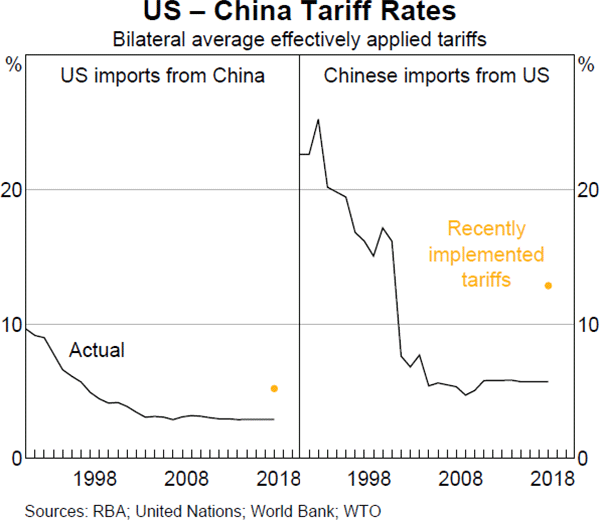
Moreover, the US administration has begun a process that could lead to higher tariffs on an additional US$200 billion of imports from China; China has indicated that it would respond. The United States has also mooted an increase in tariffs on automotive imports from a range of countries and is continuing to pursue the renegotiation of key trade agreements on what it considers to be more favourable terms for the United States. If these additional tariffs are implemented, and if US trading partners responds, the direct impact on global GDP growth will be larger but still relatively modest. However, if such an escalation significantly affected business decisions, the adverse effects on the real economy could be more significant.
These developments have weighed on asset prices in economies and industries that are more exposed to trade with the United States. In China and some other Asian economies, asset prices have declined and currencies have depreciated, reflecting the importance of trade for the region and its integration into global supply chains. In Europe, the automotive sector has been particularly affected by trade developments. In the United States, equity prices have been little affected by trade developments (Graph 1.4).
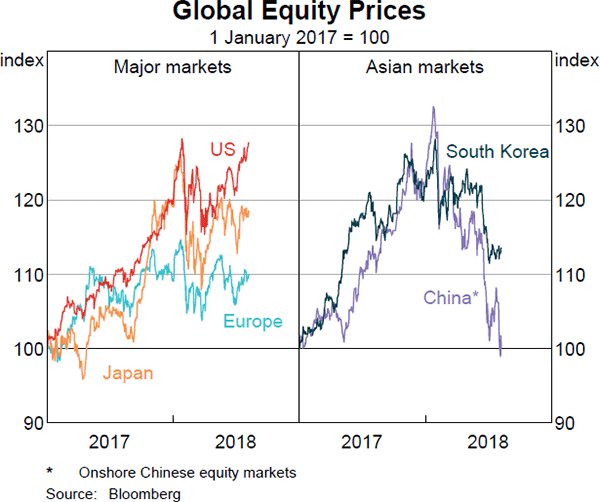
Growth in the major advanced economies continues to absorb spare capacity …
In the major advanced economies, GDP growth remains above estimates of potential growth (Graph 1.5). GDP growth in the United States has gained significant momentum, while growth in Japan is likely to have picked up in the June quarter, following a weak March quarter outcome. Growth in the euro area has moderated somewhat from the relatively strong rates of last year. In all three economies, strong labour market conditions have supported growth in household spending and business conditions remain positive.
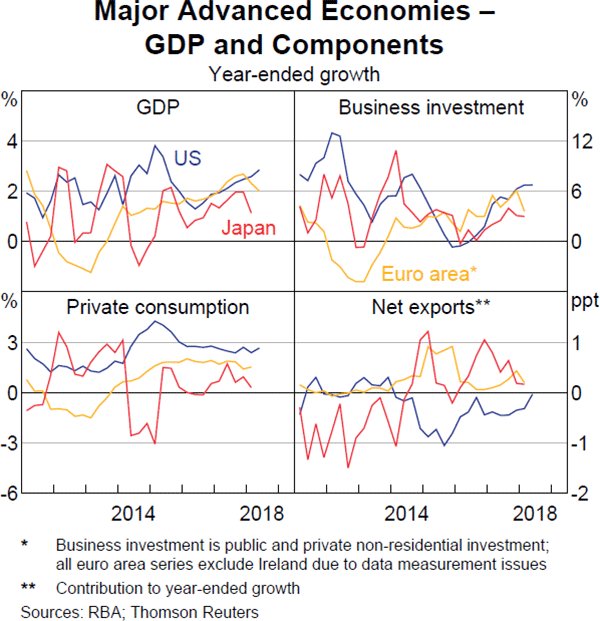
In the United States, GDP growth and labour market conditions have been strong for some time. The recently enacted tax cuts have contributed to growth in household and business spending of late. Consumption growth increased in the June quarter and is expected to remain strong in the period ahead. Business investment growth has continued at a fast pace as spare capacity in the economy continues to be absorbed; survey measures of investment intentions point to further strong investment growth in the near term (Graph 1.6).
GDP growth in Japan is likely to have recovered somewhat recently – following the weak outcome at the start of the year – driven by a strong pick-up in investment. Business investment intentions have continued to strengthen and point to a further pick-up in investment growth this year. Labour shortages appear to be especially severe in Japan; this is likely to be contributing to the strength in business investment, as companies increase capital to supplement their workforce.
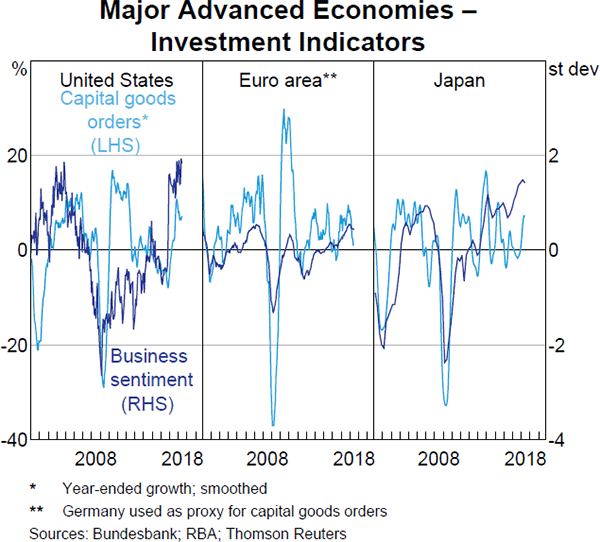
In contrast, growth in the euro area has slowed a little relative to a year ago. The near-term prospects for business investment growth in the euro area have eased a little; survey measures of business conditions and new capital goods orders have fallen from the very high levels of late 2017. However, conditions remain supportive of further above-potential growth in GDP: labour markets are strong, business sentiment remains quite high and capacity utilisation is increasing.
Labour markets in the major advanced economies have strengthened further as the economic expansion has continued (Graph 1.7). Employment growth remains high and faster than the growth in working-age populations. This has been associated with steady declines in unemployment rates, which in many economies are at multi-decade lows. Measures of underemployment also continue to move lower. Job vacancies have increased strongly in the United States and Japan in recent years, where they are around record highs.
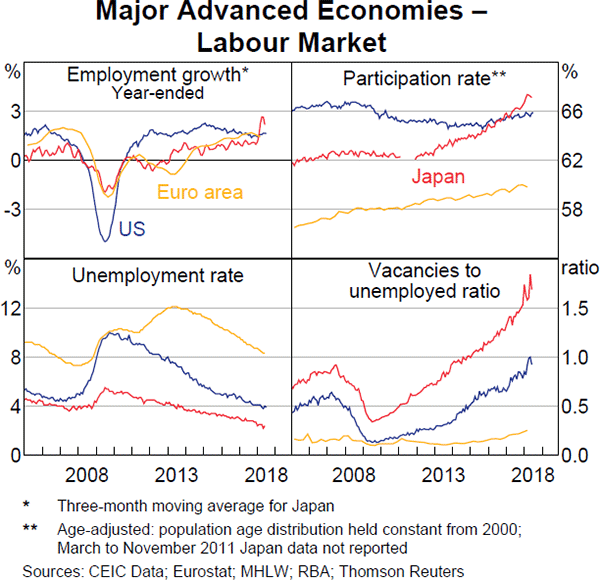
Survey measures of capacity utilisation have increased and supplier delivery times have lengthened considerably across major advanced economies. An increasing number of firms are reporting that labour shortages are limiting their ability to increase production, even though labour supply – in the form of increased labour participation – has also increased significantly in some economies. In the euro area, manufacturers are also increasingly reporting lack of equipment as a factor limiting production.
… so wages growth is expected to increase further
Nominal wages growth has increased in the major advanced economies as spare capacity in labour markets has been absorbed (Graph 1.8). In the United States, wages growth is around the highest level in this economic expansion. In Japan, part-time hourly wages growth has increased steadily over recent years and is around its highest level in over a decade; full-time wages growth has picked up since the start of the year. Wages growth in the euro area has picked up noticeably over the past two years and the increase has been broad based across member countries.
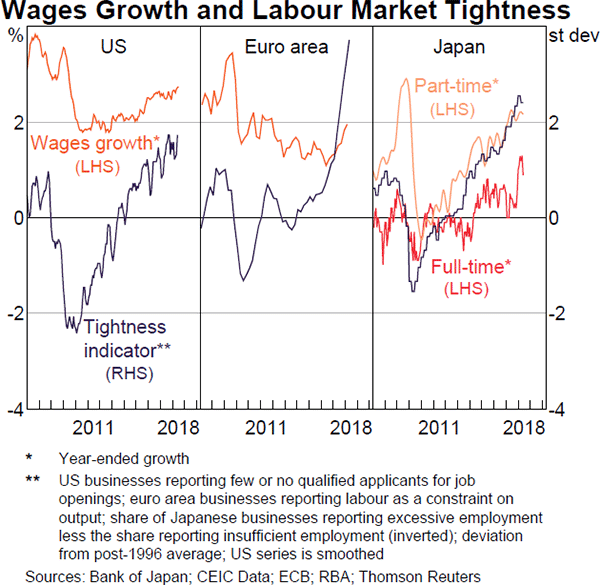
Further increases in nominal wages growth are anticipated in these three economies as capacity pressures become more pronounced. US consumers and firms are expecting higher wages growth, and wage negotiations between labour unions and employers in the euro area and Japan over the past year have resulted in higher outcomes.
Notwithstanding the recent pick-up, nominal wages growth in the United States and the euro area is still fairly low by historical standards. However, growth in unit labour costs is currently around or above the post-crisis average in both economies, as growth in labour productivity has been modest.
Core inflation has picked up in some economies
Headline inflation has increased with the pickup in oil prices this year and core inflation has increased to be around the inflation target in a few economies, including the United States, United Kingdom, Canada and Sweden (Graph 1.9). However, core inflation remains low and is below the inflation target in other advanced economies. Services inflation has been particularly low in the advanced economies during the post-crisis period.
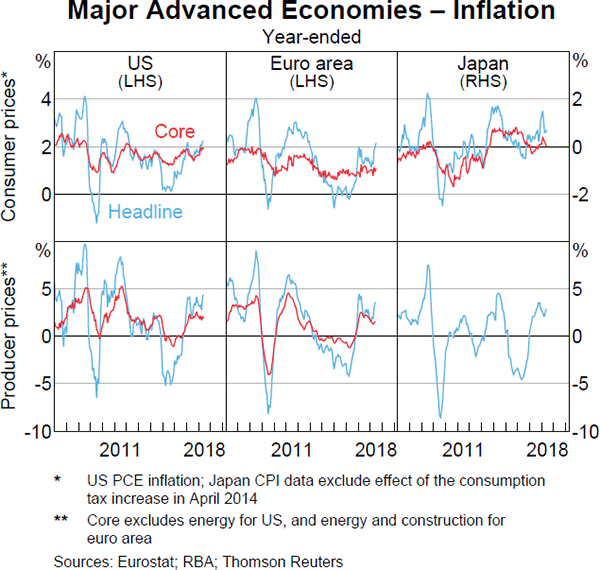
Increasing capacity pressures in product and labour markets across major advanced economies are expected to add to inflationary pressures. Producer price inflation has picked up over the past year or so and is running at around its highest rate for several years. The US fiscal stimulus is expected to add to inflationary pressures because it is coming at a time when capacity constraints are increasingly binding (Graph 1.10).
Consumer and market-based inflation expectations have increased in the United States over the past six months, but have been unchanged in the euro area and Japan. Consensus forecasts are for inflation to remain around target in the United States and below target in the euro area and Japan over the next 18 months.
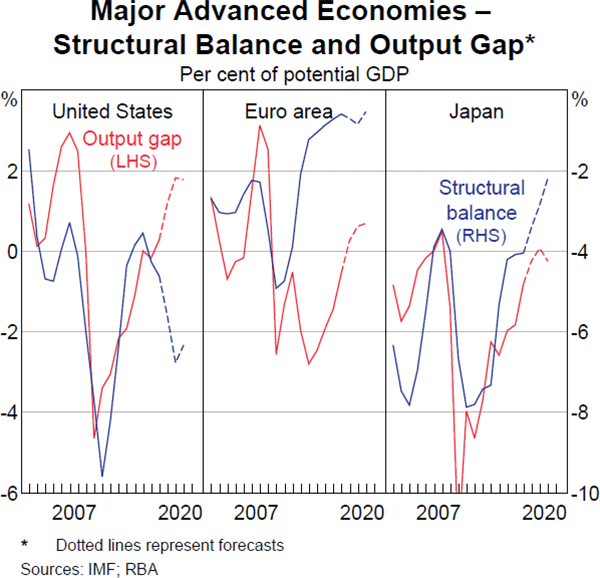
The major central banks are at different stages of their monetary policy cycles
Monetary policy settings across advanced economies remain expansionary. But the major central banks are at different phases of their monetary policy cycles, reflecting differences in the amount of economic slack and the outlook for inflation across economies (Graph 1.11).
After a prolonged period of monetary easing after the global financial crisis, US policy rates have increased gradually in recent years and the Federal Reserve's balance sheet has declined by around 4 per cent of GDP. The median of Federal Open Market Committee (FOMC) member projections suggests that the federal funds rate will be increased six more times by the end of 2020, to be around ½ percentage point above the level that members judge to be neutral for the economy (Graph 1.12). However, market pricing suggests both a slower pace of rate increases and a lower terminal rate for the cycle. The Federal Reserve's balance sheet is expected to continue to decline at a gradual pace but remain well above pre-crisis levels.
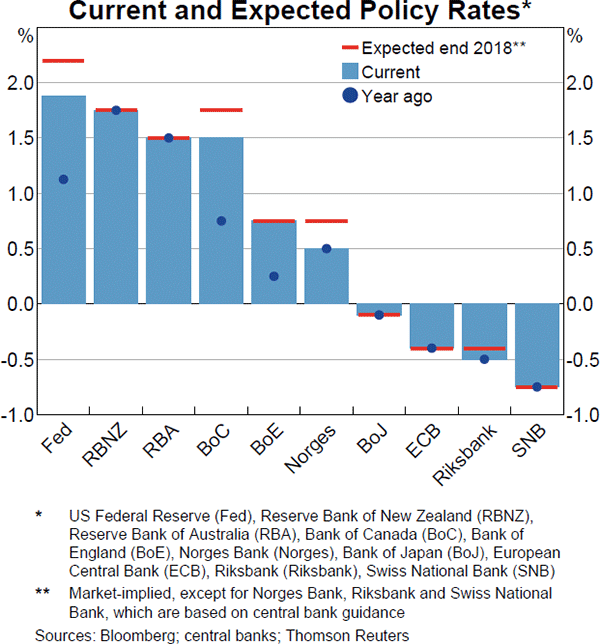
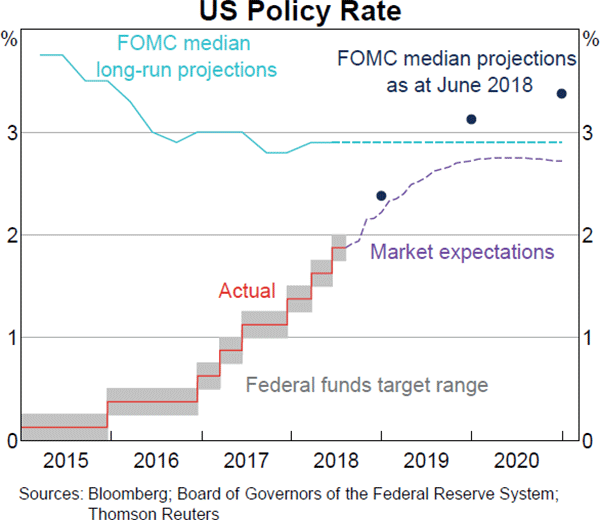
In Europe and Japan, monetary policy settings continue to be very expansionary. Negative policy rates are expected to remain in place for some time yet, and balance sheets have continued to expand (Graph 1.13). The ECB plans to reduce its net asset purchases in October and end this program by December 2018. However, it will continue to reinvest the proceeds of maturing securities for an extended period, so its balance sheet will remain large and thereby contribute to accommodative financial conditions. Market participants expect the ECB policy rate to remain unchanged until the second half of 2019.
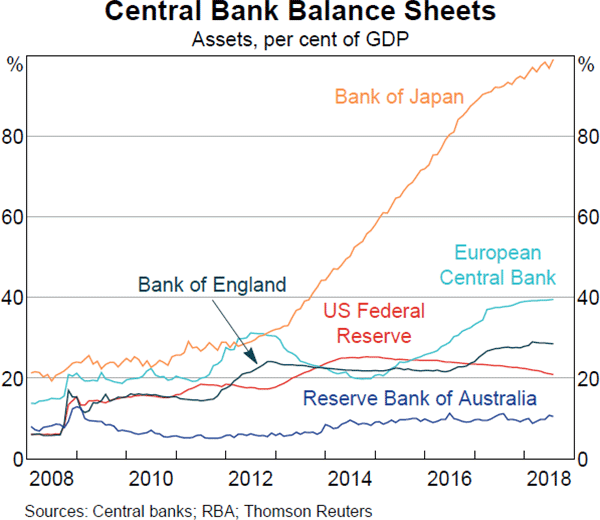
The BoJ introduced additional flexibility to its yield curve control framework at its July meeting. While the BoJ maintained its target of ‘around zero’ for 10-year government bond yields, it increased the tolerance for deviations from this target from 10 to 20 basis points. The BoJ also introduced forward guidance, stating that it intends to maintain extremely low interest rates for an extended period. In the update to the economic outlook, the BoJ lowered its inflation projections and extended the time horizon it expects for inflation to reach target.
Elsewhere, policy settings remain broadly expansionary. While policy rates have increased in Canada and the United Kingdom, and are expected to rise in Norway and Sweden by the end of the year, policy rates remain very low overall and mostly well below rates of inflation. Central banks in other advanced economies – such as New Zealand and Switzerland – are expected to remove monetary stimulus at a more gradual pace.
Broader financial conditions remain supportive of economic activity
More generally, financial conditions remain accommodative in the major advanced markets. Yields on government bonds are low, and spreads on corporate bonds and leveraged loans are narrow. In the United States, equity valuations are above their historical averages. Measures of interest rate, exchange rate and equity volatility remain below their long-run averages.
Short- and long-term government bond yields in advanced economies generally remain low. While long-term yields in a number of advanced economies have moved in a relatively narrow range over the past year, those in the United States have increased along with a notable rise in short-term yields (Graph 1.14). This divergence across countries partly reflects differences in expected policy stances of the major central banks. Recent adjustments to the BoJ's operational framework prompted a rise in Japanese government bond yields to their highest levels in a couple of years but they remain low. Political developments in Italy (see below) and a moderation in the pace of euro area growth this year have also contributed to a decline in bond yields in northern Europe.
The cost of borrowing US dollars unsecured at short terms remains elevated relative to policy rate expectations (as indicated by Overnight Index Swaps (OIS)), but this spread has decreased in recent months (Graph 1.15). Some funding pressures have subsided; in the second quarter the US Treasury reduced its net issuance of Treasury bills from the high levels earlier this year, although issuance is expected to pick up again later in the year. However, other pressures persist, partly related to ongoing shifts in the size and composition of the cash and securities portfolios of US corporations in response to changes to US tax laws, and the gradual reduction in the size of the Federal Reserve's balance sheet. Money market conditions in other jurisdictions have been little changed recently, with the exception of Australian dollar markets (see ‘Domestic Financial Conditions’ chapter).
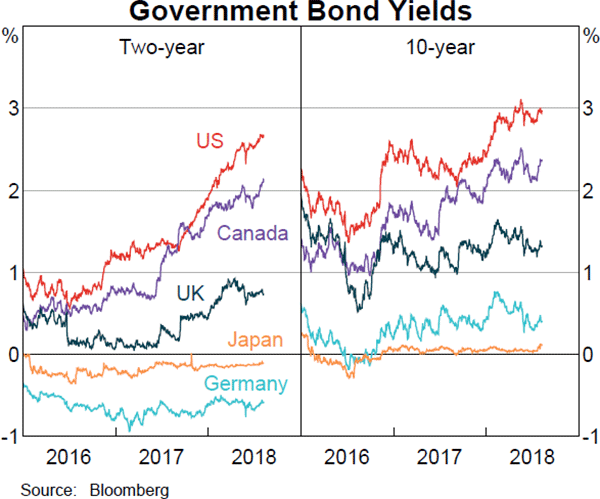
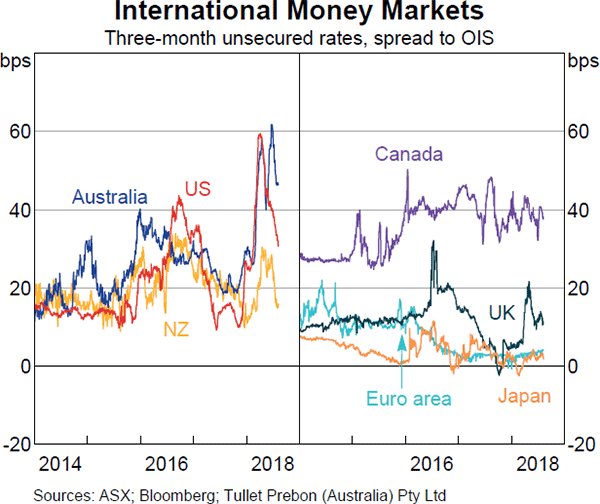
A positive earnings environment for corporations continues to underpin equity prices and low spreads on corporate bonds (Graph 1.16). In the United States, share prices have also been supported by recent changes to corporate tax laws and increased merger and acquisition activity. Current market pricing suggests only a modest impact of trade-related uncertainty on corporate profitability in the advanced economies. Increased debt issuance to fund merger and acquisition activity by large, highly rated firms has contributed to a modest widening in investment grade corporate bond spreads this year, but corporate borrowing costs remain low.
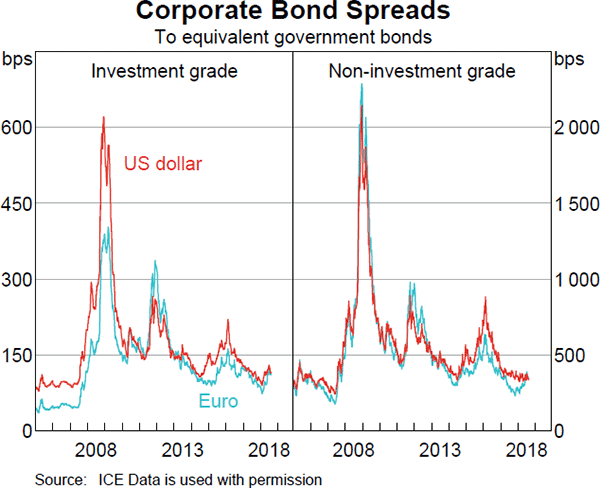
While financial conditions in advanced economies remain supportive of growth, a number of risks could see them become less stimulatory. These include an escalation in trade tensions between the United States and its key trading partners, an increase in Italian sovereign risk premia and higher-than-expected US inflation, which could prompt market participants to price a faster withdrawal of monetary policy accommodation by the US Federal Reserve (see ‘Economic Outlook’ chapter).
Developments in Italy have been a focus of financial markets
In Italy, concerns related to fiscal policy and spillovers to the domestic financial system have increased after a populist coalition government took office in late May. The new administration has proposed a program of tax cuts and spending increases which, if enacted, could substantially widen Italy's budget deficit. Concerns over the sustainability of Italy's already large government debt burden and the possibility of a sovereign credit rating downgrade have contributed to a material increase in the spread between Italian government bonds and German Bunds (Graph 1.17). This has weighed on equity and bond prices of Italian banks, which have significant holdings of Italian government bonds. While broader spillovers across the euro area have so far been limited, Italian sovereign bond spreads are likely to remain elevated and volatile over coming months as markets await further details on the Italian Government's budget plans.
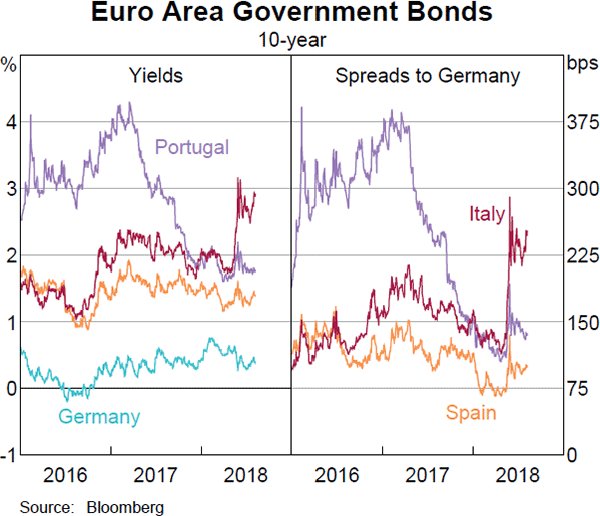
The US dollar has appreciated against most currencies
The US dollar has appreciated against a broad range of currencies in recent months, and is about 4 per cent higher than it was at the beginning of the year on a trade-weighted basis (Graph 1.18). The appreciation of the US dollar against the currencies of advanced economies has occurred in the context of relatively firmer prospects for US economic growth and inflation, and commensurately higher short-term interest rate differentials. A moderation in euro area growth and political developments in Italy have also contributed to a modest depreciation of the euro against the US dollar this year.
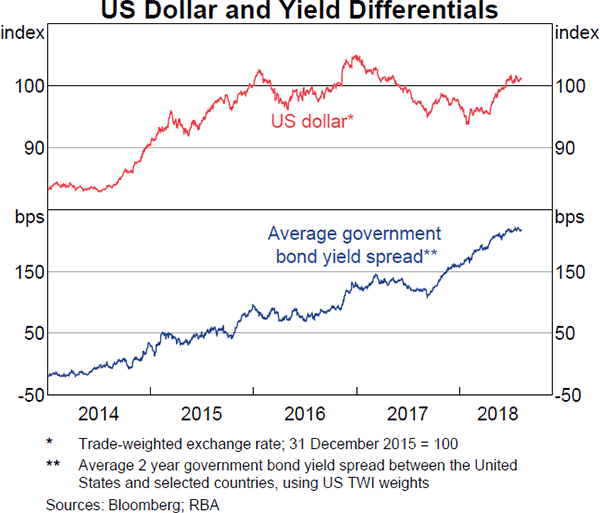
Financial conditions have tightened in some emerging markets
Emerging market asset prices have generally declined and currencies have depreciated against the US dollar since earlier this year as a number of emerging market economies have experienced sizeable capital outflows (Graph 1.19). The shift in market sentiment has occurred against a backdrop of more difficult external conditions for some emerging markets, exacerbated by domestic policy settings in some cases. For oil-importing economies, higher oil prices have contributed to a widening in current account deficits.
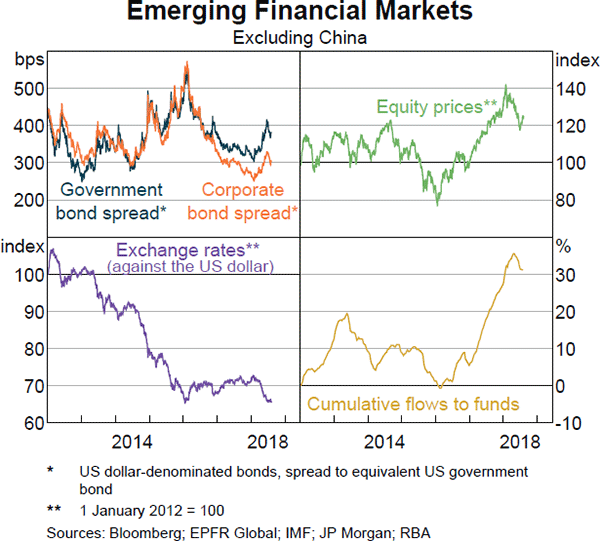
The shift in market conditions has been most pronounced for a few economies with significant financial, economic, political and/or institutional vulnerabilities – notably Argentina, Brazil, Turkey and Pakistan (Graph 1.20):
- In Argentina, market concerns have centred on fiscal sustainability, central bank independence and high levels of foreign currency-denominated debt. In June, the Argentine authorities negotiated a sizeable financial assistance package with the International Monetary Fund. In response to financial market pressures, the Argentine central bank has substantially increased interest rates, raised bank reserve requirements and intervened in the foreign exchange market.
- In Brazil, concerns over the government's ability to reduce the fiscal deficit, labour strikes and uncertainty around the upcoming elections in October have put downward pressure on asset prices. The central bank has intervened in recent months in response to the depreciation of the real.
- In Turkey, the lira has depreciated and bond prices have fallen sharply. This reflects concerns over central bank independence, accelerating inflationary pressures, widening current account and fiscal deficits and political tensions with the United States.
- In Pakistan, the central bank devalued the exchange rate in July for the fourth time since December 2017. The central bank has sold around 10 per cent of its foreign currency reserves since April, following a sharp widening of the current account and fiscal deficits.
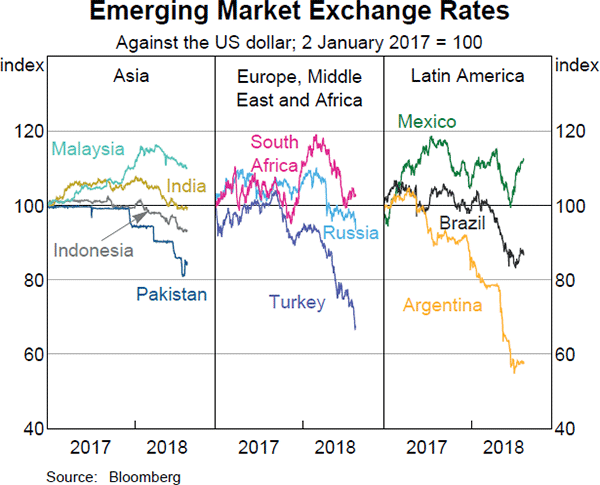
By contrast, other emerging markets in Asia have generally been more resilient to the tightening in external financing conditions this year (see ‘Box A: Financial Market Resilience of Emerging Asia’). Nevertheless, the region is exposed to an escalation in international trade tensions or a more general slowing in global growth.
Chinese growth has eased a little
In China, real GDP growth has eased a little in year-ended terms since last year, consistent with a steady tightening of financial conditions (Graph 1.21). Conditions in the industrial sector have been subdued, with industrial output flat or falling across numerous industries. Crude steel production remains elevated, however, which has continued to support Australian exports of bulk commodities in recent months (see ‘Box B: An Update on China's Steel Sector’). Growth in services sector activity remains relatively strong, which the authorities have attributed to rapid growth in the information technology, software and business service industries.
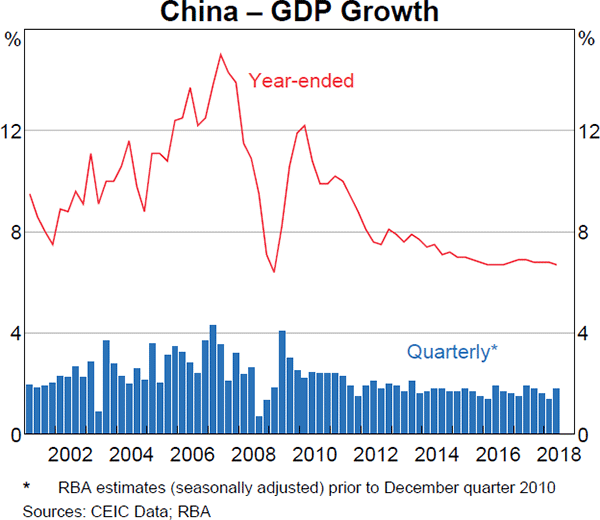
Real investment grew modestly in the June quarter. Growth in measured private fixed asset investment has continued to strengthen, reflecting increased capital spending by the manufacturing sector. In contrast, growth in public investment has eased further, in line with the authorities' efforts to control growth in local government debt and reduce financial risks (Graph 1.22). Real consumption growth strengthened in the quarter, supported by growth in consumption of services. Growth in retail sales of consumer goods has fallen over the past year; the weakness has been apparent across a broad range of product categories, including cars. In June, the Chinese Government announced details of planned personal income tax cuts (as well as new tax deductions for education, medical treatment and rent) to support household disposable income and consumption.
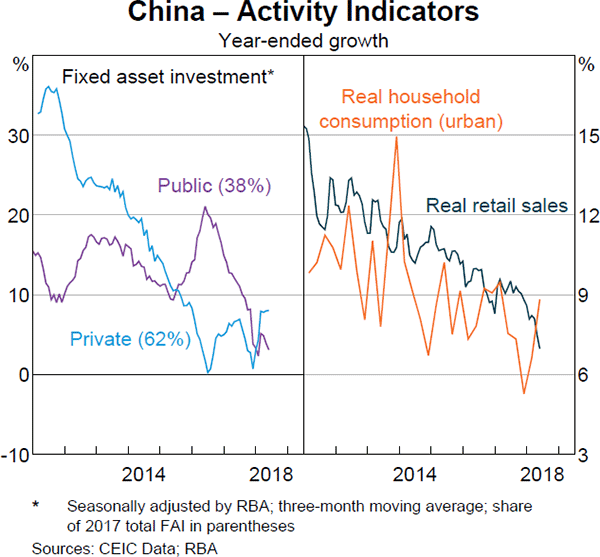
Conditions in Chinese property markets remain strong overall (Graph 1.23). Housing prices have increased rapidly across the country. Property sales have increased recently, partly absorbing existing inventory, which has been flat or falling in many cities. Measured residential investment growth has remained robust in recent months, mainly reflecting growth in the value of land purchases. While actual construction work has declined recently, advance sales of apartments (off-the-plan) have picked up strongly, which could support construction activity (and thus demand for steel) in the second half of the year.
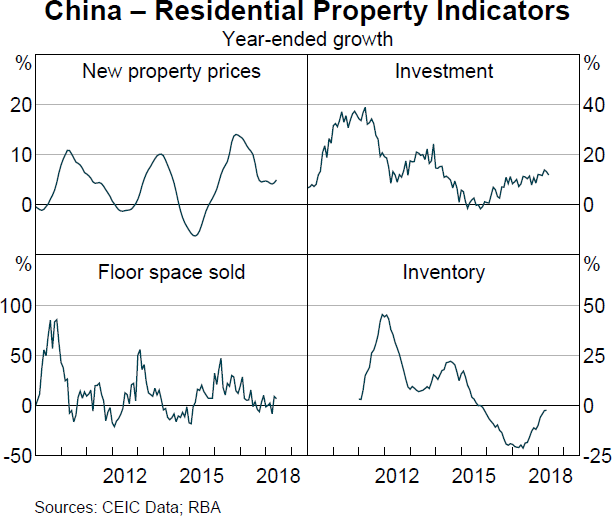
In year-ended terms, both headline and core inflation have been little changed in recent months. After moderating noticeably over the past year, producer price inflation (PPI) has risen because of sharp increases in manufacturing, mining and raw material prices (Graph 1.24).
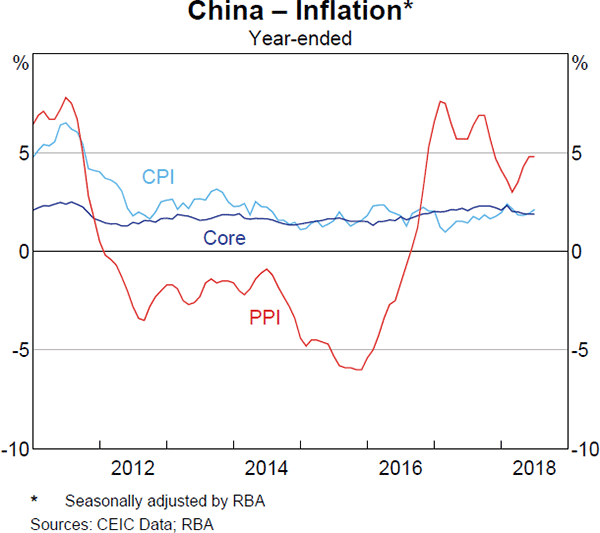
Chinese authorities are taking measures to avoid a material slowing in growth …
In response to weaker growth in parts of the economy and concerns about escalating trade tensions, the Chinese authorities have announced measures to avoid a material slowing in growth. The central authorities have moved to ease fiscal policy in a targeted fashion. In July, the government issued guidelines on urban transport planning to support public infrastructure investment; by ensuring investment is concentrated in locations with the capacity to meet new expenditure from budget revenues, the central authorities are also seeking to improve the sustainability of local government debt. In addition, the government announced measures to increase the scope of tax deductions for research and development spending, to progress projects in transport, gas and telecommunications industries with significant private sector involvement, and to expedite bond sales to help local governments fast track infrastructure investment projects.
The People's Bank of China (PBC) has also taken actions to ensure liquidity conditions remain ample, which has helped guide money market rates to their lowest levels since late 2016 (Graph 1.25). In particular, the PBC reduced banks' reserve requirement ratios for the second time this year in July. In the associated guidance, the authorities indicated that they preferred the resulting release of funds to be used by small banks for loans to small and micro-sized enterprises and by large banks for debt for equity swaps. The PBC also injected liquidity through its medium-term lending facility and issued guidance to banks to ease financing conditions for small businesses.
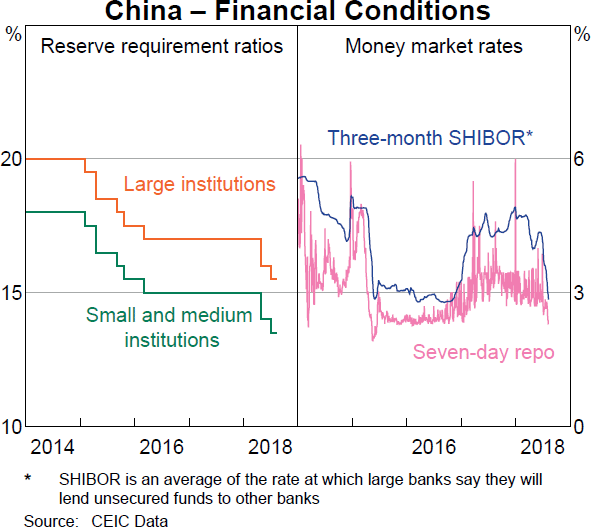
… while responding to financial stability risks
The Chinese authorities have continued to enact measures to contain the build-up of financial risks. These measures have focused on: improving the transparency of the financial system; tightening regulations on risky forms of lending such as ‘shadow banking’ activity; and improving the risk and liquidity management practices of financial institutions.
The tightening of regulations has contributed to a broad tightening of financial conditions (particularly outside traditional bank lending) over the past couple of years. This has been evident in the slowing in the growth of total social financing (Graph 1.26). Growth in bank lending remains relatively strong, but has eased a little since the start of 2018. Growth in mortgage lending to households has declined this year in response to further steps taken by the authorities to control property purchases. Growth in overall business lending has also eased somewhat.
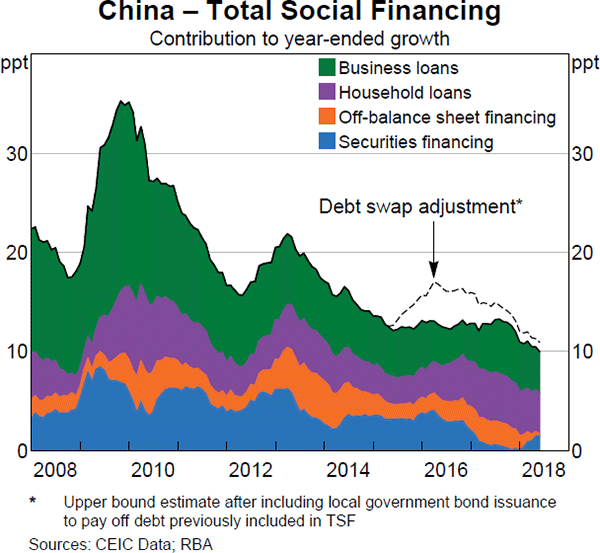
Over the same period, a decline in shadow banking activity has been partly offset by a modest pick-up in the growth of securities financing (particularly corporate bond financing), which had been weak for most of 2017. An uptick in corporate bond defaults (albeit from very low levels) and a reduction in credit intermediated through shadow banks have contributed to an increase in corporate borrowing costs, particularly for lower-rated borrowers. Chinese equity prices have declined sharply in recent months, reflecting some uncertainty over growth in China against the background of tighter (non-bank) credit conditions and rising trade tensions with the United States.
The Chinese currency has depreciated
The Chinese renminbi has depreciated in recent months, after appreciating earlier in the year. The depreciation has been larger against the US dollar than on a trade-weighted basis, reflecting the broad-based appreciation of the US dollar (Graph 1.27). Rising trade tensions with the United States, the moderation in economic growth and signs of monetary policy easing in China are also likely to have contributed.
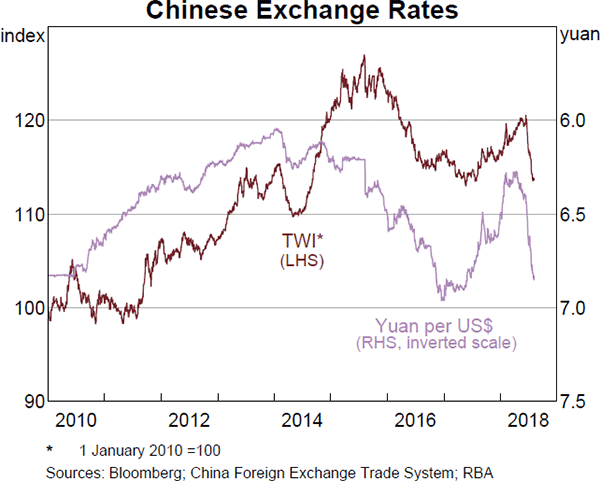
There is little evidence to date of a notable pick-up in private capital outflows from China and China's foreign currency reserves have been little changed. This is in contrast to 2015 and 2016, when there was heightened uncertainty about Chinese economic growth, large private capital outflows and reserves declined by close to US$1 trillion.[1] However, on occasion the renminbi fix has been set at a rate that may have slowed the pace of depreciation. The authorities have also reintroduced a reserve requirement for banks (which was removed in 2017) that will make it more expensive to sell renminbi in the forward market.
Growth in the rest of Asia remains strong
Growth elsewhere in Asia (excluding China and Japan) remains strong, after picking up over the past two years. Indian GDP grew strongly in the March quarter to be 7.7 per cent higher over the year (Graph 1.28). GDP growth in year-ended terms has been steady in Korea and Indonesia this year, but has slowed a little in Singapore and Vietnam.
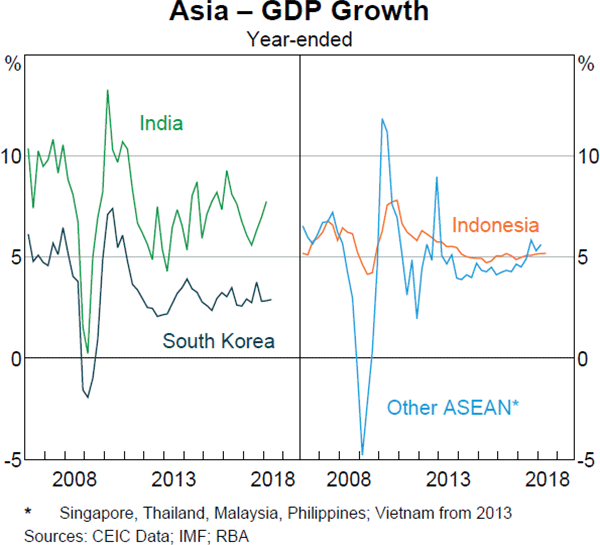
Stronger domestic final demand has been driving GDP growth in the region recently, whereas external demand had been a more important driver of growth over 2017 in some economies. Consumption has contributed significantly to growth across the region and is likely to continue to do so given the above-average level of consumer confidence. Growth in government and private consumption has been particularly rapid in India over the past year (Graph 1.29). Business investment growth has been strong in Indonesia. It had also been strong in Korea over the past two years, boosted by the pick-up in external demand for electronics, but slowed in the June quarter as the build-up of capacity in the electronics sector appears to be nearing its completion. A recovery in tourism from China has supported growth in Korea in recent quarters. Employment growth slowed in Korea following the 16 per cent increase in the minimum wage in January that is estimated to have affected wage conditions of about one-quarter of the labour force.
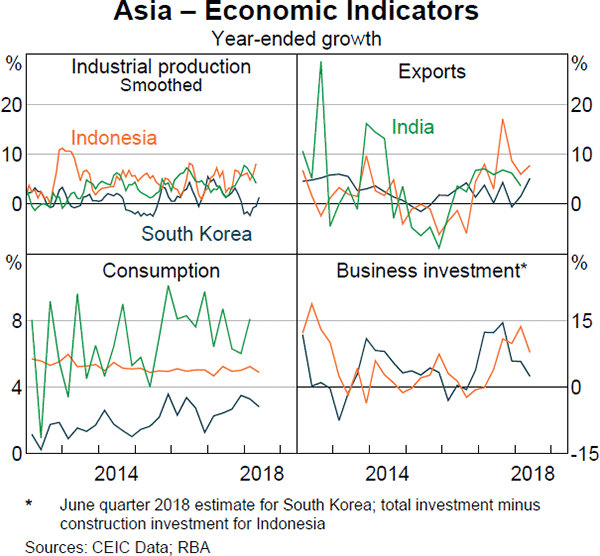
The region's export growth remains relatively strong and survey measures of new export orders have rebounded in recent months (Graph 1.30). While the United States is a major destination for the region's exports, the direct effect on the region of higher US import tariffs has been limited for now because the tariff measures have been focused on China. However, exports to China are a major share of the region's trade and some are used in the production of Chinese exports, which will be affected by the higher US import tariffs (Graph 1.31). A reduction in Chinese exports is likely to result in lower demand for the region's exports and subtract somewhat from its GDP growth.
Industrial production growth has picked up in most of the region after the sharp fall in late 2017 and electronics production generally remains strong. Surveyed business conditions have eased this year to be around average.
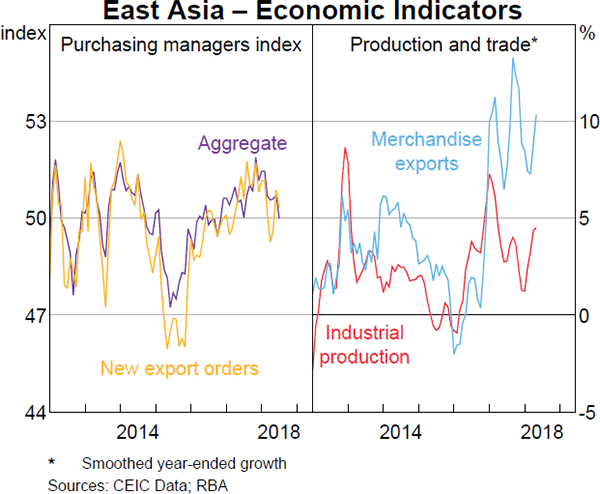
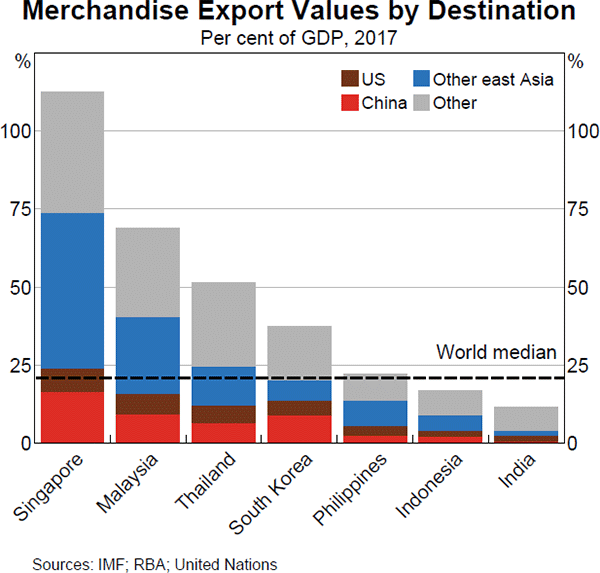
Inflation remains generally subdued in the region (Graph 1.32). However, inflation is still above the Reserve Bank of India's medium-term inflation target of 4 per cent. Inflation has increased in the Philippines, as a result of strong demand-side pressures and higher food prices following an increase in excise taxes. Monetary policies remain generally accommodative, although some central banks have raised policy rates in recent months.
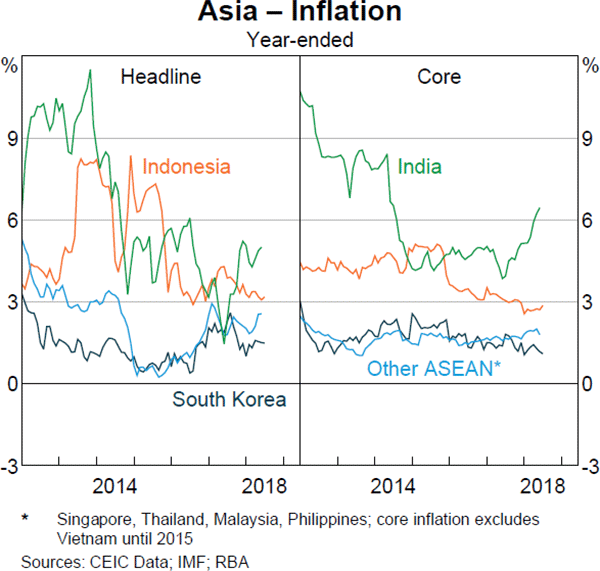
Commodity prices have been mixed in recent months
Developments in global commodity prices have been mixed since the previous Statement (Table 1.1; Graph 1.33). Base metal prices are lower following concerns about the outlook for global industrial production in light of trade developments. Meanwhile, bulk commodities and rural prices are higher (nominal wool prices remain at historically high levels), while oil prices are little changed.
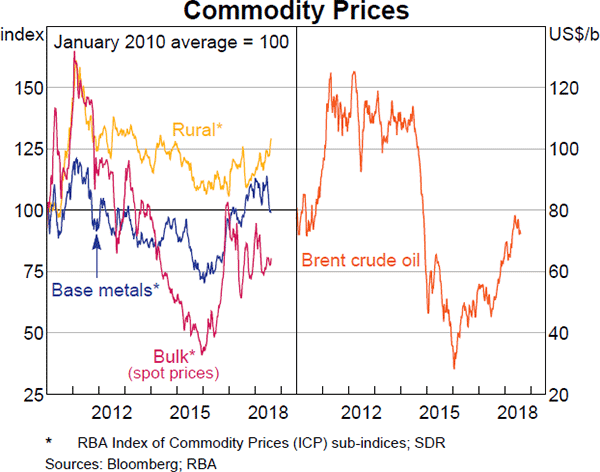
The spot price of thermal coal has risen significantly, boosted by strong demand from Asia (partly due to warmer than usual weather), as well as a range of supply issues in some of the largest exporting economies (Graph 1.34). A benchmark price for the 2018 Japanese fiscal year contract has reportedly now been agreed at US$110 per tonne; settling this benchmark took longer than usual, in part because spot prices were increasing while negotiations were underway. The coking coal spot price has increased since the previous Statement, while the June quarter contract price was set at around 20 per cent lower than the March quarter benchmark; more than half of Australia's coking coal exports are estimated to be sold on contract. Nevertheless, both the spot and contract prices remain around the high levels that have prevailed over the past two years.
| Since previous Statement | Over the past year | |
|---|---|---|
| Bulk commodities | 7 | −6 |
| – Iron ore | 3 | −14 |
| – Coking coal | 5 | −10 |
| – Thermal coal | 21 | 24 |
| Rural | 8 | 14 |
| Base metals | −9 | −4 |
| Gold | −5 | −3 |
| Brent crude oil(b) | −2 | 38 |
| RBA ICP | 0 | 6 |
| – Using spot prices for bulk commodities | 4 | 3 |
|
(a) Prices from the RBA Index of Commodity Prices (ICP); bulk
commodity prices are spot prices Sources: Bloomberg; IHS; RBA |
||
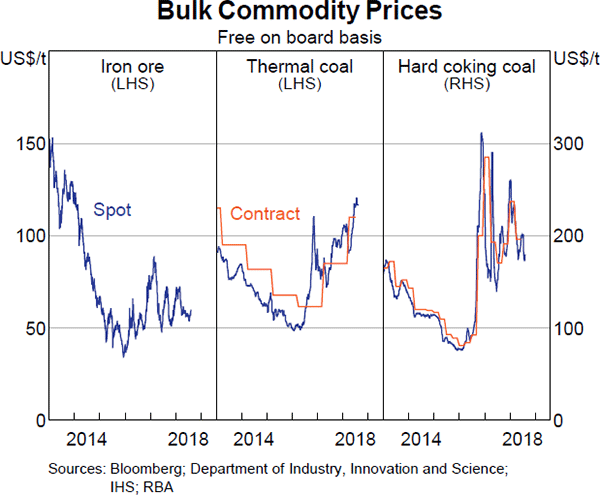
The spot price of iron ore has traded in a relatively narrow range owing to broadly offsetting forces. Increased demand associated with higher Chinese crude steel production appears to have been largely balanced by rising seaborne supply from Australia and Brazil. Demand from steel producers – particularly in China – for higher quality inputs in order to support more efficient production has contributed to an elevated discount for the price of lower quality iron ore products. Around 40 per cent of Australia's iron ore exports are estimated to be of lower grade ore and subject to discounts.
Oil prices are little changed since the previous Statement and remain at a high level. Prices have been supported by the strength in global demand and supply disruptions in several countries, although uncertainty around global trade policy has weighed on prices.
Australian export prices are expected to remain around their recent levels in the near term, before gradually declining over the coming years as Chinese demand for bulk commodities moderates and further low-cost global supply comes on line. Consequently, the terms of trade are expected to remain around recent levels for a few quarters before declining, but to remain above their trough in early 2016 (as discussed in the ‘Economic Outlook’ chapter).
Footnote
McCowage M (2018), ‘Trends in China's Capital Account’, RBA Bulletin, June, viewed 16 July 2018. [1]